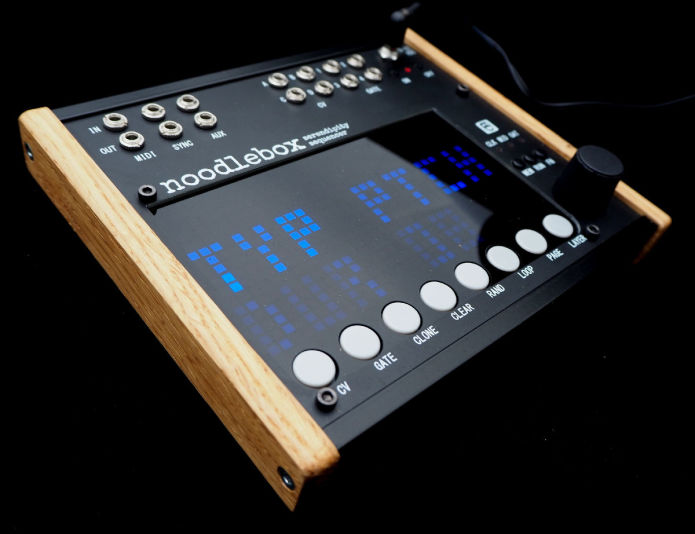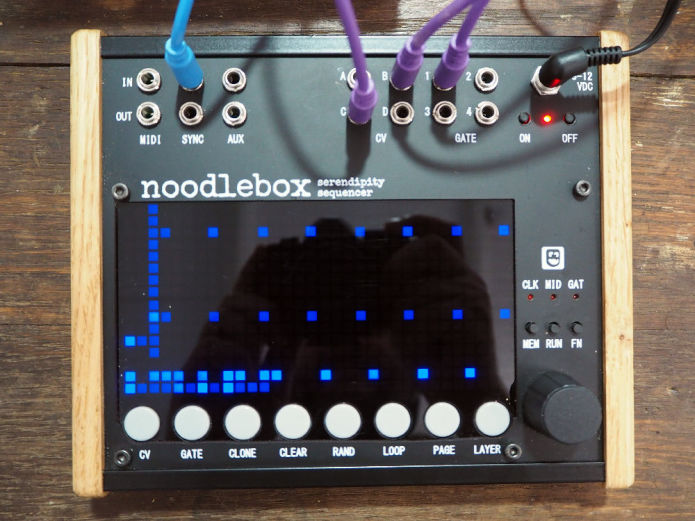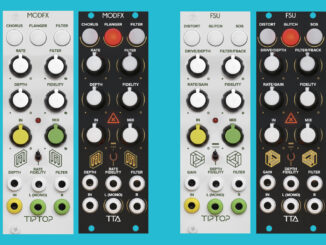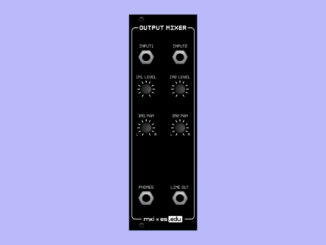Noodlebox is a 4 track MIDI / CV step sequencer with analog CV/Gate output for each part, MIDI and designed for happy accidents.
For some time now, Jason Hotchkiss, developer of the beloved CV. OCT MIDI to CV converter has been teasing his new super portable sequencer Noodlebox. Now it seems that it arrived in the final phase of development, as the device is now available for pre-order on Indiegogo.
Noodlebox looks cute and is super smart. But do not be mistaken, there is a lot of sequencer power in this small device. It offers in a total of 4 sequencer layers/tracks, each with analog CV/Gate outputs and MIDI connectivity. Each layer runs separately to the others (although staying in sync) and has its own step count, clock division, etc.
The idea of Noodlebox came about from experience playing with simple knob-based step sequencers such as the Korg SQ-1, and in particular some experiments I did with linking multiple SQ-1s together in interesting ways (setting different sequence lengths/clock divisions, adding pitch CVs, multiplexing between CV outputs, swapping gates between sequencers and so on). What got me most excited were the quirky grooves and melodies that emerged; unplanned but inspiring to build upon, tweak and refine.
The sequencer engine goes deep: each layer has four pages with up to 32 steps each. You can use the pages for A/B/C/D type pattern variations or just build a song with it with verse, chorus, etc. If 32 steps are not enough, you can also chain all four pages and get a single pattern with up to 128 steps. Further, you can cue up lists of pages for automatic cycling (up to 32 pages) and the unit lets you arrange pages very quickly and easily even in a live situation.
Each step has a value range of 0-127 corresponding to row position of the data point in the scrolling window. This value corresponds to a chromatic or scale-forced note pitch CV (V/Oct or Hz/V output) or to a general-purpose modulation CV (0 to 8V range). Freely mess with scaling modes during playback for microtonal weirdness! User-entered CV points can be padded or interpolated into empty steps for fast creation of melodies and modulation slopes without the need to enter a value at every step. Voltage slew can be introduced between data points.
Flexible Gate Settings
In the Noodlebox you can work not only with CV but also with Gate signals very flexibly. Gate points can easily be edited separately from CV points, so you can experiment with the rhythm of a fixed melody and vice-versa. The gate length (duty) is adjustable at layer level and any step can be “tied” to the next for legato play or rhythmic variation. Gates can be managed manually or by a Euclidean algorithm. You can also assign to each gate point probability, retrigger/ratchet and accent (for MIDI velocity). Gate timing can be micro-offset for swing and slide effects, with or without randomness.
Layers 2, 3, 4 can internally modulate the CV output of the previous layer by summing with it or overlaying it. This requires no special cable patching and can be used for automated transposition or adding simple variations to a sequence, right up to meandering microtonal craziness.
MIDI Sequencer
The four sequencer layers not only send out CV / Gate but also MIDI data. Very practical for everything that is not modular or CV/Gate related. They can output classic MIDI notes but also controller change (CC) messages, on shared or different MIDI channels. You can also record MIDI notes from an external keyboard into the Noodlebox which can be quantized into the grid while the sequence plays. It can also be used as a straightforward MIDI looper.
It also includes a wide range of different editing features that are hands-on designed: cloning/erasing data points, shifting patterns in pitch and timing, loop points, play direction, adding/removing randomness… The sequencer also has eight memory slots that store all four layers of a session. A very handy auto-save memory slot is used when shutting down using the OFF-button. With this, you can backup your previous session. A special memory slot can also be prepared as a “template” for new sessions to save commonly used settings.
Hardware Details
The hardware is based on a 32-bit ARM Cortex M0+ processor and equipped with a firmware that is user-updateable via MIDI SYSEX message. It includes input sockets for MIDI (3.5mm TRS jack. MMA standard “type A”), sync in on 3.5mm mono jack and an AUX in with a selectable function.
On the output side, you can find a MIDI Out (3.5mm TRS jack. MMA standard “type A”), sync out on 3.5mm jack, AUX out with a selectable function, 4 gate outs (10V pulses, 4 CV out (0-8V range) with V/Oct, Hz/V, and selectable linear voltage scaling.
At first glance, I like this sequencer very much. Could be the little brother of the Winter Modular Eloquencer but only in standalone and much smaller.
Sixty Four Pixels Noodlebox is available now for pre-order for 345€ on Indiegogo.
More information here: S4P







Be the first to comment